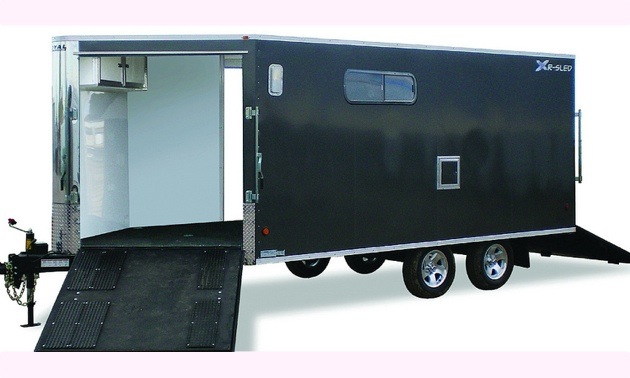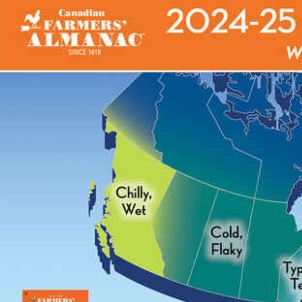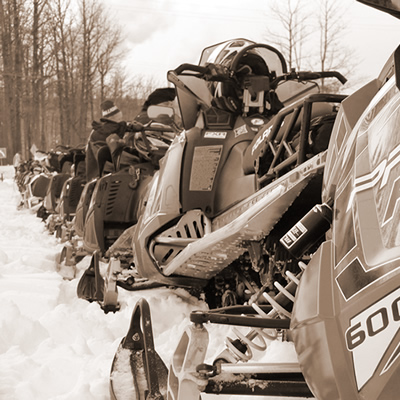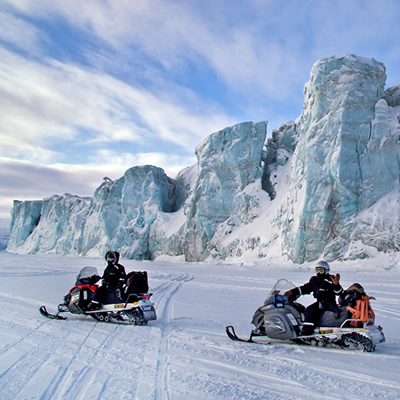I grew up in the small northern mining town of Thompson, Manitoba. We were a family of sledders, four of us, but at times we had upwards of six sleds. For my brother and I we had a red Yamaha Bravo, an orange Elan and a yellow Tundra. Mom and dad had bigger machines, both Polaris, a Cutlass SS and Indie Trail. The Cutlass was eventually upgraded to a liquid cooled Indie 400, and when we got older we could take it for a rip. It was fast.
Despite having all those sleds, we never had a trailer. We transported our sleds by loading them in the back of our truck by running up a snowbank or a three-quarter-inch sheet of plywood as a ramp. Usually we took one sled, but sometimes we needed to transport two. That was a chore, turning the sleds perpendicular to the truck and hanging the tracks over the side of the box. Those were the days.
I am sure the struggles of loading sleds in the back of trucks helped bring about the evolution of the recreational sled trailer, much as loading horses and cattle in pickups prompted the invention of stock trailers.
Either way, the expensive cargo moved from the back of the truck to behind the truck and the differentiation started there.
I won’t bore you with all the bumps and steps along the way, but fast forward to today and there are a lot of choices out there. Here are some points to consider:
Open deck or an enclosed trailer?
An open deck trailer is significantly less cost than an enclosed sled trailer and easier to tow than a large enclosed trailer. If you do not mind some road slush on your sleds (salt shields and rock guards mitigate this) and you want something easy to move around, this is the choice for you. Now you just need to decide between steel and aluminum.
Steel versus aluminum
Aluminum will last longer and does not suffer as badly from weathering or mechanical road chip damage. The trailers tend to have the same capacity, but if you go with a well-built steel trailer they will be stronger and will be able to do more than just haul your sleds or recreational vehicles. That tends to be the deciding factor between buying aluminum or steel: If you think you’re going to use it for more than just sleds, buy a steel open sled deck trailer, as it will handle the abuse better. Otherwise, buy the aluminum. It pulls way easier, and if you are putting on some miles you will appreciate that fact.
Choosing an enclosed sled trailer
You decided you did not want to clean off your sleds every time you reach your destination. Or you need somewhere to store your machines in the summer, or you want to work on your sleds out of the wind in the staging area. Whatever your reasons, you’re going to buy an enclosed trailer. Now, which type? Your options are many.
To help you understand your options, here is how they’re generally classified:
How many sleds they carry: 2 place, 3 place or 4 place.
Deck height: lowboy (deck is as low to the ground as possible) mid-deck (the deck is raised for some clearance but not too high, keeping the ramp angle down) and highboy (the deck is above the wheels so the platform is a full eight feet wide).
Width, which tends to fall into two broad categories: 7 feet or 8 feet wide (which is really 8’6” wide).
Lastly, the frames will either be steel or aluminum.
When it comes to deciding which class of trailer is right for you, it really comes down to your specific needs, but I will give you some things to consider with the most popular classes that may help your decision making.
2 place, highboy, 8’6” wide:
This class of enclosed sled trailer tends to be the most economical. It is usually single axle without brakes, so a half ton truck can pull it with no problem. They are often aluminum so they are quite light, which makes them even easier to move around. It is a great starter enclosed trailer. The downside of this trailer is that unless you bump up to tandem axles you do not have a drive-off front ramp, and if you add another axle and a front ramp your costs skyrocket. That said, with a reverse option on today’s sleds, is a front drive-off ramp really needed?
2 or 3 place, lowboy, 7 feet wide:
This trailer with a steel frame is also very economical. Being 7 feet wide and lower to the ground means they pull well behind a truck. Plus they are tandem axles so their ride is smoother than a bouncy single axle trailer. They also have a front ramp so you can drive your sleds in and out with ease. Beyond those points this trailer is also being used year round as a traditional cargo trailer because it is just the right size—not too big, not too small. Contractors love the access to the trailer with two ramps. The downside of these trailers is that the loading of three sleds can be difficult, but once you figure out the configuration needed it is not an issue. As well, being only 7 feet wide there is not a lot of room on the inside for cabinets and racking.
3 or 4 place, lowboy, 8 feet wide:
These enclosed units have become more popular as a multi-use unit or toy haulers. Instead of just sled trailers, the ramp can be reinforced and you can haul a car or side-by-side MUV if you make the rear door opening high enough. If you have a lot of different toys this becomes a really economical option. Instead of two trailers you can get one built for all your toys. The downside is that you have full size fender boxes inside the trailer to maneuver around when loading your sleds. Trust me, that is not a difficult issue, and if it is, are you sure you want to chase powder between the trees? The other issue with the lowboys is adding a heater. Generally the propane tanks will have to go on an extended hitch so your trailer gets a little longer overall.
3 or 4 place, mid-deck, 8 feet wide:
These units are another popular class of toy hauler, but with a little bit more clearance. The extra clearance comes in handy for added features such an underbelly-mounted fuel tank and propane tanks. The fender boxes inside the units are not as high and can be easily driven over. The disadvantage of these units is the extra clearance; if it is going to be a toy hauler trailer a lot of cars will not be able to make it up the higher angled ramp.
3 or 4 place, highboy, 8 feet wide:
If there is a traditional enclosed sled trailer, this is it. It is still the most popular option for an enclosed trailer. It has a full width deck, so it is very easy to drive and position your sleds for travel. The full width provides lots of room for cabinets and racking on the walls. They have lots of clearance, they track well behind a vehicle on snowy roads, plus with all the deck clearance there are no problems adding options such as on-board fueling stations or under-deck mounted propane tanks. Quite simply, they are specifically designed to load sleds and all their accessories. The downside is their height makes it harder to load cargo or recreational power sport vehicles, and in a cross wind they act as a big sail and push the tow vehicle around a lot.
There many other options to consider when buying a sled trailer, such as adding heat or cabinets, the type of interior walls, little features such as kick plates and floor drains—the list is endless. I was talking to a manufacturer about his enclosed sled trailer production run this year and he estimated that 90 per cent of the trailers will be unique coming down the line. The point is, there are a lot of choices in the marketplace. Make sure that when you are looking for a trailer you talk with someone who can educate you and provide you with all the options so you can get your trailer, your way.







